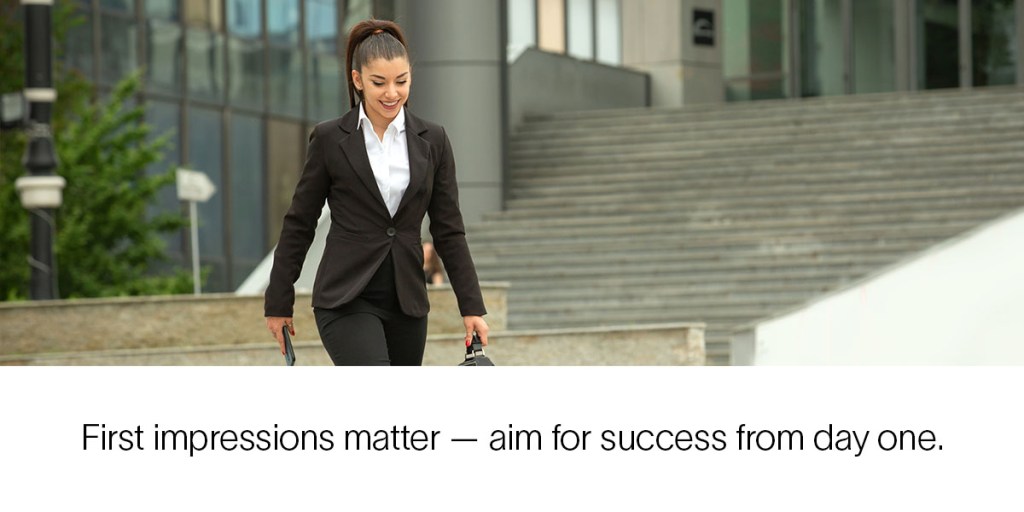The job market is increasingly competitive, with demand often outpacing available roles. One 2024 report found that job growth grew by 7% while applications surged by 31% — intensifying competition among candidates. Applicants who want to stand out must prepare for every stage of the job search process.
A strong strategy may increase the chances of securing an opportunity and stepping into a fresh role with confidence. Understanding how to get a new job means mastering the entire process. Each step builds momentum toward professional success.
Table of Contents
- How to Start Looking for a New Job
- How to Apply for a New Job
- How to Prep for a New Job
- Your Next Opportunity Starts Here
How to Start Looking for a New Job
The process of applying for new jobs starts earlier than one might think. Before applying, individuals must take an introspective approach to better their chances of finding a fulfilling career that provides long-term stability. Through thoughtful preparation, professionals can align their next role with their long-term aspirations.
Time for a Career Change?
First, candidates must determine whether now is the right time for a career change. The following signs can indicate that change may be necessary:
- Daily work lacks engagement or inspiration.
- Growth opportunities remain limited despite strong performance.
- Values no longer align with the company’s mission.
- Individuals have a clear sense that another role would better fit their long-term goals.
Recognizing these signs helps us understand why we want a change. For instance, would a new role at the current company remedy the issues, or would an individual benefit from a new role at a new company? Perhaps a completely different field may satisfy their needs.
Additionally, candidates should remember that a successful career transition takes time, especially when making an intentional move. Applicants must analyze their personal and professional aspirations, research market trends, explore various industries and fulfill the job’s requirements.
Time to Grow

If a career change feels right, the next step involves gaining an understanding of professional goals. This step allows for a more well-thought-out career roadmap. Rather than submitting applications on a whim and getting stuck hopping from one job to another, candidates can enjoy an established career.
The GROW framework provides four essential steps that help people make smarter career change decisions:
- Get clear: Applicants must first define their long-term aspirations through a career and life review process. Identifying strengths and interests helps create a clear path forward and clarifies whether a new role aligns with one’s career goals.
- Recognize the results: Reflect on past experiences and career achievements. Acknowledging one’s success and challenges could pinpoint areas where additional skills or knowledge may be necessary, which helps guide future decisions.
- Own the impact: Candidates should also reflect on the results identified in the previous step and note the emotions experienced. This step may seem trivial, but understanding how actions influence professional success helps strengthen confidence and self-awareness, which could help articulate one’s value to potential employers.
- Where and what else: Applicants can consider new opportunities that align with their personal and professional growth and skills. These connections help individuals brainstorm where and what they can apply for.
With a clear decision made, candidates can officially start applying for jobs.
How to Apply for a New Job
A strong application process sets the stage for a successful career move. When applying for jobs, each stage of the process plays a role in securing the right position.
Before Applying
A strong foundation may lead to better results. Before applying, candidates should complete the following steps:
- Define goals and preferences: Opportunities emerge when applicants have clear career goals. Applicants must identify their professional preferences, which could include remote flexibility, leadership opportunities and specialized skill development. Knowing what one wants helps refine the search and strengthens decision-making.
- Organize the application process: Candidates can set up an easy-to-follow method of tracking each application. A spreadsheet or job-tracking tool will do, and it can help manage application dates, contact details and follow-up reminders. Applicants can also document feedback from interviews and use it for future improvements. Staying organized maintains momentum.
- Refine resume and cover letter: Applicants must tailor their resumes and cover letters for each job application to build stronger connections with hiring managers. One’s experience, skills and quantifiable achievements must follow clear and relevant formatting to add credibility. Keyword optimization can also help the applicant tracking systems pick up a candidate’s application.
- Gather essential documents: Keeping essential documents accessible prevents last-minute stress. Applicants must ensure they have their supporting documents, like certificates and recommendation letters, ready to streamline the application process.
- Strengthen digital presence: Recruiters value strong online profiles. A polished LinkedIn page, for example, can highlight an applicant’s expertise. Strengthening one’s digital presence involves engaging with industry-related content, regularly updating one’s profile, joining professional discussions and connecting with recruiters.
During the Application Process

Every submission represents a step toward the next opportunity. Applicants must consider the following when applying for positions:
- Review applications before submission: Attention to detail goes a long way and strengthens applicants’ credibility. Always review resumes, cover letters and any job-specific responses to ensure these documents align with the role’s expectations. Even small details like grammar and formatting can leave a lasting impression.
- Stay responsive to recruiter communications: A timely response demonstrates professionalism and enthusiasm to recruiters. Candidates should answer emails, finalize scheduled calls and provide requested information without delays.
- Customize application answers: Many applications include additional questions. To strengthen applications, provide clear, concise responses with relevant examples. Through these Q&As, applicants must showcase their problem-solving skills, leadership experiences and adaptability.
- Keep track of application progress: A spreadsheet or tracking tool helps candidates record application timelines, prevent missed opportunities and keep track of follow-ups. Applicants should note submission dates, responses and interview invitations.
- Prepare for prescreening interviews: Applications may be followed by initial interviews or assessments. Candidates should always carefully review job descriptions to prepare themselves for such cases. Confidence in early interactions sets a strong tone for the hiring process.
- Follow application instructions carefully: Each employer sets specific application guidelines. Reading instructions thoroughly and following submission steps precisely avoids unnecessary disqualification. Again, attention to detail reflects professionalism.
- Leverage networking during the process: Reaching out to connections within target companies may add credibility. Engaging with professionals on LinkedIn and attending industry events can strengthen industry presence.
- Engage with the company’s content: Researching a company’s website, social media profiles and news updates provides insight into its culture. Engaging with relevant posts or commenting on industry discussions shows additional interest and initiative.
- Be patient and stay proactive: Application processes vary in length. While waiting for responses, continuing to apply, upskilling and networking keep momentum strong.
After Applying
After sending an application, individuals must stay engaged and follow up — which could help them land the job of their dreams. Consider the following steps after applying for a job:
- Monitor and follow up: The hiring process takes time, and each company’s processes differ. Applicants must check application portals and email updates to ensure no opportunities slip through. A brief, professional follow-up email, typically after a week or so, expresses continued interest. Remember to track each application in a spreadsheet or another job-tracking tool.
- Stay prepared for interviews: Opportunities arise quickly, and one must remain prepared. Practice responses and prepare thoughtful questions in interviews to demonstrate readiness. Applicants can also do mock interviews to refine their presentation skills. Additionally, reviewing job descriptions before interviews ensures alignment with expectations.
- Continue the search: Applications work best in numbers. Consistently exploring new listings increases the chances of finding the right fit. Diversifying search methods — job boards, company websites and referrals — expands opportunities. Staying ready and adaptable to unexpected opportunities may further foster success.
- Maintain a growth mindset: Each application builds experience. For instance, each interview refines future efforts, while persistence strengthens resilience. This mindset goes beyond job applications — candidates should stay informed about relevant industry trends and upskill where needed.
A well-prepared application journey sets the stage for a fulfilling career move. After landing a job, applicants must continue the momentum and prepare for jobs — the first few months at the new job set the stage.
How to Prep for a New Job
Landing a new job brings a mix of excitement and anticipation. The transition marks a fresh start, filled with new challenges and opportunities. New hires can prepare to ensure a confident and smooth entry into the role.
Week Before
Job prep can start as early as the week before, during which new hires can:
- Understand company culture and policies: If provided, review the employee handbook and company website. Learn the company’s core values and norms to help set the right expectations for the first few days. Take a step further and research the leadership teams’ backgrounds and company milestones to gain deeper insights.
- Plan the commute and logistics: If working in an office, figure out the logistics. Map out the best and alternative routes and estimated travel times. Test public transit schedules or parking availability to avoid surprises on the first day. Consider peak traffic times to understand real-time conditions.
- Gather necessary documents: New hires must have identification and other important documentation ready beforehand if required. They should also review benefit options and complete necessary enrollment forms.
- Outline goals and expectations: List personal and professional objectives for the first 90 days. Having priorities builds confidence when stepping into new responsibilities. Draft a success roadmap detailing immediate contributions and long-term aspirations.
- Set up a workstation: If working remotely, set up a functional workspace. This area must reduce distractions and aid in productivity from day one. Also, test internet speed, VPN access, software and tools to prevent troubleshooting delays.
- Build mental preparedness: Acknowledge emotions surrounding the transition. Practice mindfulness techniques and visualize success. Read industry-relevant material to reinforce confidence and preparedness.
Day Before
Before the first day, new hires must fine-tune the details:
- Review onboarding schedule: Revisit emails or human resources materials outlining the agenda. Knowing what to expect minimizes uncertainty. Familiarize oneself with key contacts and training modules to ensure a structured approach.
- Choose an appropriate outfit: Dress codes vary by workplace. Select professional yet comfortable attire in advance to eliminate morning stress. Consider dressing slightly above the expected standard to create a strong first impression.
- Prepare essential supplies: Pack a notebook, pen, charger and any other necessary equipment. Having everything in one place provides a seamless start. If working remotely, set reminders to test the microphone, webcam, and other tools and software.
- Get a full night’s rest: Adequate sleep sharpens focus and keeps energy levels high. A well-rested mind may absorb new information faster. Avoid caffeine or screens before bed for better quality sleep.
- Plan meals and hydration: Make lunch simple by prepping a nutritious meal to stay energized. Staying hydrated must also be prioritized throughout the day, so fill a large reusable water container beforehand.
First Day

New hires can make a strong and positive first impression with the following tips:
- Arrive early: Walking in five to 10 minutes ahead of schedule gives one a moment to settle in — and it shows professionalism. Checking in with reception or security ensures smooth entry.
- Meet key team members: New hires must introduce themselves to their team members with confidence. Learning names and roles helps build early connections. Engaging in casual conversations builds rapport and eases integration into workplace culture.
- Observe and adapt: Every workplace operates differently. Notice their communication styles, workflows and office dynamics to help with quick integration. Being receptive to unspoken norms enhances situational awareness.
- Engage in onboarding activities: Participate actively in orientation sessions. Always ask thoughtful questions, as this can demonstrate enthusiasm and curiosity. Completing initial training modules further reinforces understanding of organizational expectations.
- Take notes and absorb information: New processes and policies come quickly. Documenting key points makes future reference easier. Reviewing notes at the end of the day solidifies retention and understanding.
- Practice active listening: Solidify the first impression by being attentive. Nodding, summarizing key points and asking clarifying questions show engagement.
First Week
This week, new hires must aim to establish a rhythm by:
- Clarifying job expectations: Meet with the team lead or manager to discuss key responsibilities and performance metrics. With clear objectives, new hires have a clear path to success and a structured workflow.
- Becoming familiar with tools and systems: Explore the company’s various internal platforms and tools. Get hands-on practice to build confidence and prevent future potential technical hiccups.
- Scheduling introductory meetings: If possible, set up brief one-on-one chats with colleagues. This proactive approach may help build a stronger sense of teamwork and workplace connections.
- Finding a routine that works: Early on, prioritize work-life balance to create sustainability. Try different routines and approaches and see what works best. New hires can allocate time for deep work and administrative tasks.
- Reflecting and adjusting: Review how the first week went. Make any strategic adjustments to drive continuous improvement — adapt and refine.
- Engaging in team culture: Remember to participate in group discussions and social work events. Understanding the unwritten team dynamic strengthens the integration into a new role or company.
First Months
Grow into the new role in these initial months and consider the following:
- Seek feedback regularly: Constructive input helps highlight one’s strengths and areas of growth. Managers or peers can provide this feedback. One must demonstrate responsiveness to feedback to reinforce professional development.
- Contribute to team efforts: If possible, offer support on projects or initiatives to further build credibility. If the opportunity arises, volunteer for cross-functional tasks to expand one’s skill sets.
- Develop a professional growth plan: New hires must identify possible skills to sharpen or certifications to pursue to enhance their career trajectory. Mapping long-term aspirations provides direction here.
- Stay open to learning: Each experience refines expertise. So, embrace each challenge to grow, learn and adapt.
- Celebrate milestones: New hires must remember to acknowledge their progress to build motivation. Constant small achievements help contribute to long-term success and reinforce confidence.
Make a Difference in People’s Lives With Danaher
At Danaher, our team members innovate to improve the future of human health. They achieve more and collaborate with leading minds in biotechnology, diagnostics and life sciences, all while creating a measurable impact on their communities. Candidates turn ideas into impact, thriving in a culture of continuous improvement while tackling some of the world’s toughest challenges.
Danaher has a unique way of working that connects aspiration to tangible results. Candidates will excel in a collaborative environment with a team that genuinely cares about their growth. In addition, they make a meaningful difference around the world, innovating to improve global quality of life.
As part of a diverse group of leading businesses and 63,000 associates across the world, candidates can expect to:
- Receive support throughout the interview and hiring process.
- Bring their authentic selves to any role.
- Build a career across high-impact industries.
- Enjoy working for businesses that support the whole person.
- Accelerate the real-life impact of science and technology.
- Collaborate with teams worldwide.
- Access an evolving portfolio of best practices.
As part of the Danaher Talent Community, candidates will experience meaningful career growth as they impact the world. We love hearing from passionate individuals from diverse backgrounds, and we believe in a positive and collaborative hiring process. From the first interview, our team demonstrates transparency, providing a communication timeline and access to a candidate portal.
Together, we can make a real difference. We aim to ensure each candidate’s experience lives up to our promises, giving them all the tools they need to realize life’s potential.
Your Next Opportunity Starts Here

Success starts with preparation, but growth continues with the right opportunities. Consider starting your next opportunity at Danaher, where innovation drives breakthroughs in science and technology — improving lives worldwide. Collaboration, continuous learning and impact shape every career here.
Staying ahead means staying connected. Join our Talent Community to receive exclusive updates on career opportunities, company events and industry insights. Stay informed, stay inspired and be part of something bigger.
Take your next step
Explore these links to start your career journey with Danaher today.

Leave a Reply